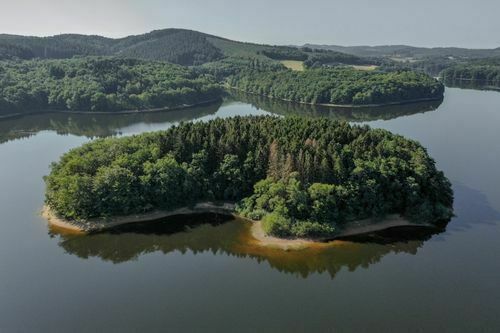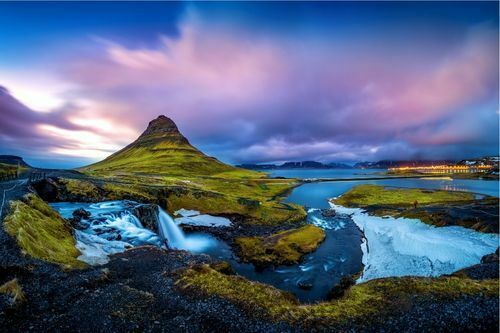Table of Contents
- Peninsula: an overview
- How is a peninsula formed?
- Examples of 10 Largest Peninsulas in the World
- Ranking of Peninsula
- Arabian 1,250,006 (Sq. Mi)
- Deccan 800,004 (Sq. Mi)
- Indo-China 748,553 (Sq. Mi)
- Horn of Africa 726,975 (Sq. Mi)
- Alaskan Peninsula 579,153 (Sq. Mi)
- Labrador Peninsula 540,543 (Sq. Mi)
- Scandinavia 289,577 (Sq. Mi)
- The Balkans 257,414 (Sq. Mi)
- The Iberian Peninsula 230,400 (Sq. Mi)
- The Kamchatka Peninsula 100,000 (Sq. Mi)
- Key takeaways
- FAQs
A peninsula is a piece of land that is connected to the mainland on one side but is surrounded by sea on the other three sides. A substantial portion of the mainland is connected to a neighboring water source via this unusual physical structure.
Peninsula: an overview

The Latin words pene, which means ‘almost,’ and insula, which means ‘island,’ when combined, form the word peninsula which is a landform that resembles an island but is not an island.
The island is a separate geographic feature that is surrounded by water on all sides, whereas the Peninsula is only surrounded by water on three sides. A lake, river, sea, or ocean surrounds a peninsula. A peninsula can also be referred to as the titles capes, promontories, spits, bill, points, and headlands.
These geographical formations, which can be found on every continent and practically everywhere on Earth, can be incredibly big or incredibly small, wide or narrow, but they are all distinct geographical regions.
These unique geographic areas support diverse flora and fauna, as well as the natural habitat of many threatened or endangered species. They frequently play an important role in global trade and commerce due to their distinctive geographic positioning. Lighthouses are built on peninsulas to avoid shipwrecks.
How is a peninsula formed?
The most frequent cause of peninsula formation is the slow movement of lithospheric tectonic plates. These plates are susceptible to the changes in the movements that occur in the earth’s core. these plates can move. Long-term tension from this movement causes fissures to form in the underlying rock, which pushes or pulls the land masses above it in different directions. Peninsulas are a result of this type of geographic activity.
Another cause is the shifting water levels that form peninsulas. The creation of a peninsula is the result of erosion caused by the sea level pressing up against the land and slowly retreating over many years.
Besides this, melting glaciers and an increase in tropical storms frequently result in land masses being surrounded by water on only a few sides, raising sea levels.
These landforms are also formed by soil erosion. Peninsulas were created as a result of the land mass becoming vulnerable to being submerged by water due to soil erosion caused by weathering processes.
Examples of 10 Largest Peninsulas in the World
Ranking of Peninsula

Arabian 1,250,006 (Sq. Mi)
The Arabian Peninsula is the largest in the world, with an area of 1,250,006 square miles. It comprises seven nations, including Saudi Arabia, Oman, Qatar, Yemen, Bahrain, the United Arab Emirates, and Kuwait. The oil and natural gas extraction and refining industries largely govern the majority of economic activities on this peninsula.
Deccan 800,004 (Sq. Mi)
With an area of 800,004 square miles, it is the second-largest Peninsula in the world and is found in South Asia. However, if you take into account the total population, Deccan surpasses all other countries in size. It encompasses the southern section of India and the Indian Ocean, the Bay of Bengal, and the Arabian Sea surrounding it on three sides.
Indo-China 748,553 (Sq. Mi)
Southeast Asia’s mainland, often known as the Indo-China Peninsula covers 748,553 square miles. It is a region in Southeast Asia that comprises nations like Malaysia, Vietnam, Cambodia, Myanmar, Laos, and Thailand. The Malacca Strait is in the southwest, the Andaman Sea is to the west, and the China Sea is to the east.
Horn of Africa 726,975 (Sq. Mi)
It is also referred to as the Somali Peninsula and is the fourth-largest peninsula in the world, measuring 726,975 square miles. It is the most well-known peninsula on the continent of Africa. The Horn of Africa is widely recognized for its wide-ranging biodiversity. In addition to 5,000 plant species, it has 220 animal species, 285 or more reptile species, 100 freshwater fish species, and more.
Alaskan Peninsula 579,153 (Sq. Mi)
The Alaskan Peninsula divides the Pacific Ocean and Bristol Bay, a section of the Bering Sea. It has a total area of 579,153 square miles. The Alaskan Peninsula includes the entire US state of Alaska. The Bering Strait in the west, the Arctic Sea in the north, and the Pacific Sea in the south surround this peninsula. However, some people only consider this narrow extended band to be part of Alaska.
Labrador Peninsula 540,543 (Sq. Mi)
It is situated in the province of Quebec and is the northeastern region of Canada.
The Labrador Sea, a portion of the Atlantic Ocean in the east, Hudson Bay in the west, and the Gulf of Saint Lawrence in the south surround this 540,543 square mile region.
Scandinavia 289,577 (Sq. Mi)
This peninsula covers 289,577 square miles of northern Europe and only has a small portion of northern Finland; it also encompasses the entirety of Norway and Sweden. The Baltic Sea borders it on the east and south, the Norwegian Sea on the west, the Barents Sea on the north, and the North Sea on the south.
The Balkans 257,414 (Sq. Mi)
Southeast Europe spans over 257,414 square kilometers, including the Balkan Peninsula. It is surrounded by the Aegean Sea in the south and southeast, the Black Sea in the east and northeast, the Adriatic in the northwest, the Ionian Sea in the southwest, and the Adriatic Sea in the northwest.
The Iberian Peninsula 230,400 (Sq. Mi)
It is also referred to as Iberia and is 230,400 square miles in area. It is situated in Southwest Europe. The Atlantic Ocean borders this second-largest peninsula in Europe on the west, southwest, and north, and the Mediterranean Sea borders it on the east and southeast. Along with others, it includes France, Portugal, Spain, and Andorra.
The Kamchatka Peninsula 100,000 (Sq. Mi)
This is located in Russia’s far east and covers an area of 100,000 square miles. It is notable for its volcanoes and is regarded as one of the UNESCO World Heritage Sites. It is bordered by the North Pacific Ocean in the South, the Sea of Okhotsk in the West, and the Bering Sea in the East. There are 160 volcanoes on the Kamchatka Peninsula, 29 of which are active.
Key takeaways
- A peninsula is a section of land connected to the mainland on one side but surrounded by water on the other three. This peculiar physical structure connects a significant chunk of the mainland to a nearby water source.
- Fissures emerge in the underlying rock due to long-term tension from the movement of tectonic plates, which push or pull the land masses above it in different directions. As a result of this kind of geographic action, peninsulas were formed.
- There are many large peninsulas formed around the world. They are in south Asia, Africa, Alaska, and Scandinavia. The Arabian and the Deccan peninsula are the two largest peninsulas in the world.
Did you find this blog informative? If so, please share your thoughts in the comments section below. Click here to contact us for more information on what is a peninsula. We would be happy to assist you with your queries.
Liked this blog? Read next: Top 10 countries for studying English | A detailed guide!
FAQs
Q1. Which country is a peninsula?
Ans- The countries are-
- Kamchatka Peninsula (270,000), Russia
- Korean Peninsula (220,847) North Korea, South Korea
- Floridan Peninsula 170,304, US (Florida state)
- Baja California Peninsula (143,390), Mexico
Q2. Which is the smallest peninsula in the world?
Ans- Peninsulas can, by definition, be quite small—sometimes no bigger than a single lighthouse, for example.
However, others contend Cape Cod is the smallest of the well-known named peninsulas.
Q3. How many peninsulas are there in Europe?
Ans- The Iberian, Italian, and Balkan peninsulas are in southern Europe. The Scandinavian and Jutland peninsulas are in northern Europe. Europe has been a major economic, social, and cultural force throughout recorded history due to the connection between these peninsulas.







